-
Product Management
Software Testing
Technology Consulting
-
Multi-Vendor Marketplace
Online StoreCreate an online store with unique design and features at minimal cost using our MarketAge solutionCustom MarketplaceGet a unique, scalable, and cost-effective online marketplace with minimum time to marketTelemedicine SoftwareGet a cost-efficient, HIPAA-compliant telemedicine solution tailored to your facility's requirementsChat AppGet a customizable chat solution to connect users across multiple apps and platformsCustom Booking SystemImprove your business operations and expand to new markets with our appointment booking solutionVideo ConferencingAdjust our video conferencing solution for your business needsFor EnterpriseScale, automate, and improve business processes in your enterprise with our custom software solutionsFor StartupsTurn your startup ideas into viable, value-driven, and commercially successful software solutions -
-
- Case Studies
- Blog
How to Validate an Email with the Truemail Ruby Gem
Email validation can be a challenging task. You can use different approaches to validate an email address but all of them have to comply with the best practices to provide proper email validation. In this article, we shed some light on the 3 different email validation techniques and present you our gem that includes these techniques and allows you to automate email validation processes.
Why do we need to validate emails?
Email validation comes in handy when you’re building a product for the marketing sphere or that has marketing features. It’s especially important when sending a large number of emails. Here are three benefits that can persuade you to add email validation functionality to your product.
#1 Increases delivery rates
Email validation will help you remove invalid email addresses from your list. This will improve email deliverability, which means marketing campaigns will be more effective and cheaper.
#2 Helps you maintain a high sender reputation
Mailboxes rate senders by different metrics to form their reputation score. If your product sends emails en masse, you have to keep your sender score high. When a sender score is low, emails automatically go to spam or even get blocked.
One of the metrics that mailboxes track is the number of invalid email addresses a sender mails things to. More invalid emails mean a lover reputation.
Email validation allows you to eliminate invalid emails and keep your sender reputation high.
#3 Improves the conversion rate
A better sender score also means that more of your emails will arrive to users’ inboxes, more people will open them, and you’ll get more clicks and better performance.
Email validation can cut business expenses significantly and improve the results of marketing campaigns.
To validate an email properly, you need to perform regex, MX, and SMTP validation one by one.
Let’s take a look at these three email validation techniques separately and then check out how we implemented all of them in our gem.
Email validation techniques
1. Regex validation
Regex is the first, lowest-level email validation method. It’s based on checking the email address via a regex pattern.
A typical email address consists of three parts: a username, the @ symbol, and a domain name.
USER = /\A([a-z0-9]+[\w|\-|\.|\+]*/i
The username has to fulfill the following criteria:
- Must be one character or more
- May contain any letters, numbers and underscore
- Must be case insensitive
- May contain periods and hyphens, but not as the first character
DOMAIN = /[a-z0-9]+([\-\.]{1}[a-z0-9]+)*\.[a-z]{2,63}/i
The domain has to fulfill the following criteria:
- Must start with a letter or number
- May contain periods and hyphens
- The TLD should contain only letters and should be between 2 and 63 characters long
- Must be case insensitive
TYPICAL_EMAIL = /(?=\A.{6,255}\z)(#{USER})@(#{DOMAIN})/
Please note that this regex pattern doesn’t strictly follow the RFC 5322. You can’t validate internationalized emails or TLD emails via this regex, such as [email protected].
2. MX validation
Mail exchange (MX) record validation is the second, DNS-level validation method. The point of this method is to check the availability of the domain that’s used in the email address with the help of DNS records.
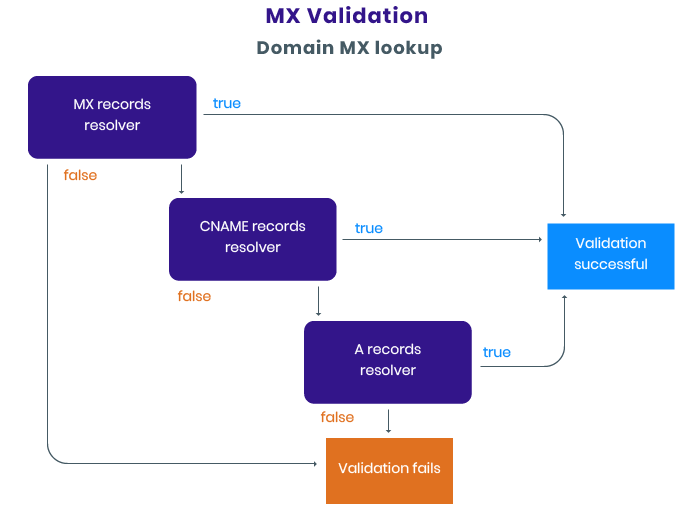
This is the schema of a typical MX domain lookup based on RFC 5321. It consists of three substeps: MX, CNAME, and A record resolution. Each resolver attempts to extract the mail servers from the email domain. If at least one server exists, validation is successful. Resolvers are checked in sequence until a resolver returns true or all resolvers fail.

The MX records resolver consists of Null MX record, and MX records check. Following RFC 7505, if a domain doesn’t accept email, it should have a Null MX record. This is an MX record with zero priority and with a period as the value. If Null MX exists, validation will fail. Otherwise, we have to check MX records. If no MX records are found, we proceed to the second substep: the CNAME records resolver.
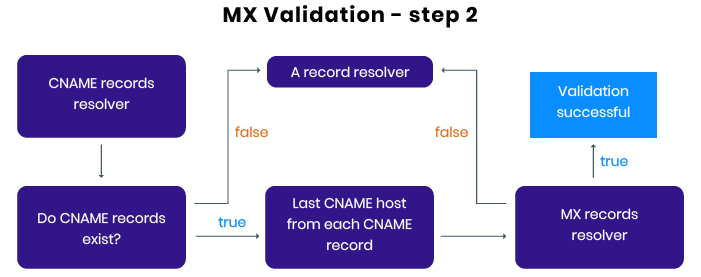
The CNAME records resolver tries to extract hosts from domain CNAME records. If domain CNAME records exist, the CNAME resolver just transfers control to the MX resolver; otherwise, it transfers control to an A record resolver.

An A record resolver checks domain A, records its existence, and saves the result as an IP address in the list.
3. SMTP validation
SMTP validation is the last high-level email validation. This method tries to determine the existence of an email address.

SMTP validation consists of two parts: checking ports and checking SMTP sessions.
The operation will be iterated until the SMTP session returns true. Otherwise, validation fails.
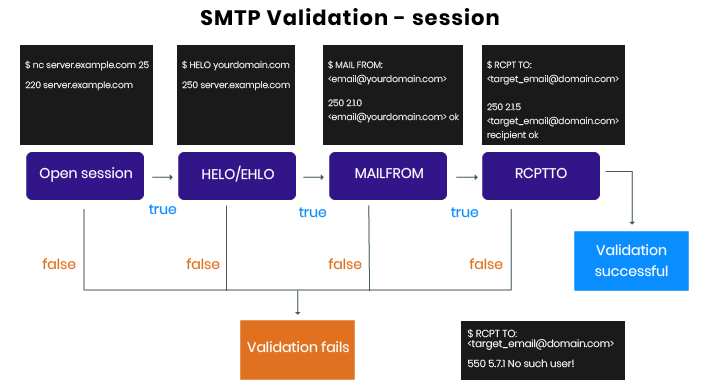
An SMTP session consists of four substeps: opening the session and three SMTP commands (HELO, MAILFROM, and RCPT TO). If an email exists, each step of the SMTP session should return status code 250.
Note that a verifier IP should have a PTR record to the HELO host for the best validation results. Also, the HELO host should be real and should have an A record to a verifier IP address where it runs. The MAILFROM argument should also exist and must include the HELO host.
What’s Truemail?
Truemail is a gem that uses all the verification methods mentioned above. It’s a lightweight, configurable, and simple Ruby email validator.
How does Truemail work?
The Truemail gem allows you to validate emails via the regex pattern, by domain DNS records, and by the real existence of an email account on a mailbox provider.
Benefits of Truemail
When we were working on Truemail, we wanted to combine all email validation methods and make this gem very easy to use. Here are the benefits you get using Truemail:
- It’s configurable. Truemail allows you to validate only those metrics you need.
- It’s lightweight. Truemail is a Ruby library with zero runtime dependencies.
- It has a simple SMTP debugger. This debugger helps us find bugs easily.
What configurable options does Truemail have?
Here’s how you can configure Truemail.
Truemail host audit
As email validation based on the existence of an email address is a complex network process, you need to make sure that your verification host corresponds to modern SMTP metrics that mailbox providers use.
That’s why we added a host audit feature in Truemail. This feature allows us to perform an audit of the host where Truegem runs and helps us determine any current host issues.
So far, we’ve implemented only PTR record audit in Truemail. This feature helps us check:
- PTR existence
- PTR reference
- Reverse trace
Here’s how we perform a Truemail host audit:
Once we’ve checked that our host works correctly, we can start email validation.
Email validation with Truemail
Below, you can see how Truemail performs regex, MX, and SMTP validation.
Regex validation
Validation with the regex pattern is the first validation level. By default, this validation isn’t performed by strictly following the RFC 5322 standard, so you can override Truemail’s default regex pattern if you want.
MX validation
Validation by MX records is the second validation level.

Truemail performs regex validation and then the MX validation itself.
The Truemail MX validator doesn’t follow the RFC 5321 standard strictly for the best validation outcome. So operation will be iterated even if one of the MX records has an unresolvable host.
SMTP validation
SMTP validation is the final, third level of validation. This type of validation tries to check the existence of an email account on a mail server.

If the total number of MX servers equals one, the Truemail::Smtp validator will use the value from Configuration.connection_attempts.
Also, you don't need to pass with-parameter to use this validation.
This is an example with default settings (smtp_safe_check param equals to false)
If there are no SMTP errors found, the validation is successful.
But what is the SMTP safe check option? By default, it’s set to false, meaning that if any SMTP errors are detected, the validation will fail.
Here you can see an example of an SMTP error with the option smtp_safe_check = false.
You can find all request instances with SMTP errors in SMTP debugger.
Now, let’s see what happens with smtp_safe_check = true.
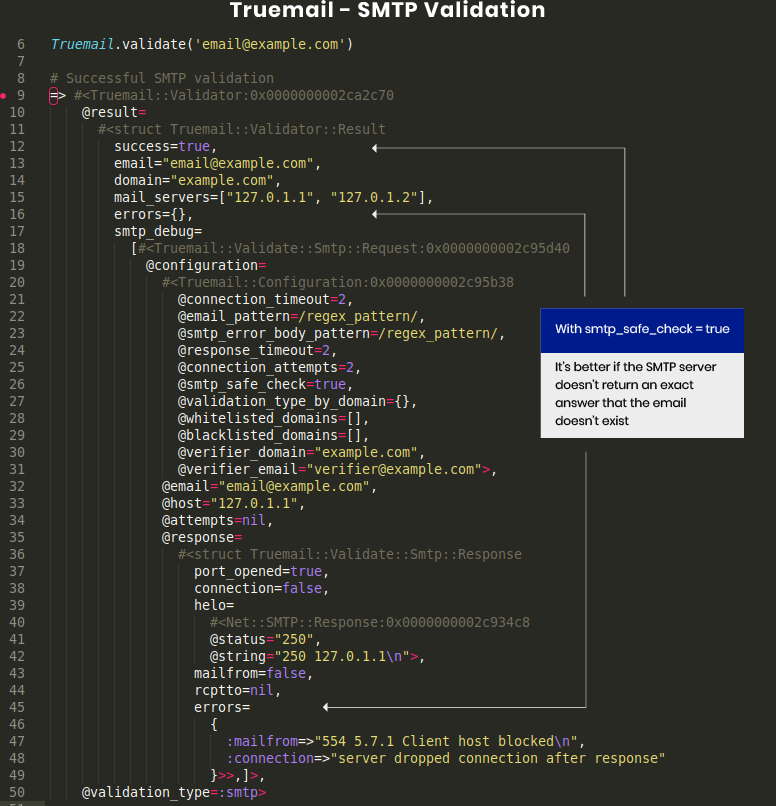
In this case we have SMTP errors, but validation is successful. Why? Because the SMTP server doesn’t return the exact response that the current email doesn’t exist. By default, SMTP safe check is disabled and is available for SMTP validation only. So what will we receive if the server returns an RCPT TO error?
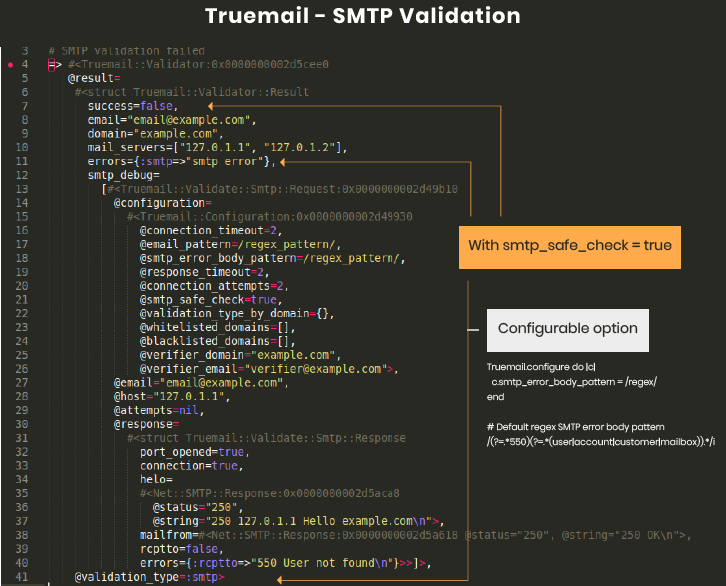
If an SMTP RCPT TO error is found, validation will fail. The SMTP error body pattern is configurable, which means you can define your own regex pattern if you need.
Truemail aims at making email validation easier and faster. You can find the full source code on our GitHub account. Feel free to ask a question or start a conversation below.












